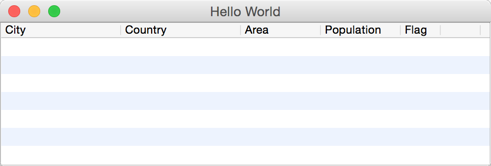1. 格式化表格(Formatting the Table)
城市数据的内容应该被现实在一个表格中。我们使用TableView
控制并定义4列:城市,国家,面积,人口。每一列都是典型的TableViewColumn。然后我们添加列的标识并移除要求自定义列代理的操作。
TableView {
id: view
anchors.fill: parent
TableViewColumn {
role: 'city'
title: "City"
width: 120
}
TableViewColumn {
role: 'country'
title: "Country"
width: 120
}
TableViewColumn {
role: 'area'
title: "Area"
width: 80
}
TableViewColumn {
role: 'population'
title: "Population"
width: 80
}
}
现在应用程序能够显示一个包含文件菜单的菜单栏和一个包含4个表头的空表格。下一步是我们的FileIO扩展将有用的数据填充到表格中。

文档cities.json是一组城市条目。这里是一个例子。
[
{
"area": "1928",
"city": "Shanghai",
"country": "China",
"flag": "22px-Flag_of_the_People's_Republic_of_China.svg.png",
"population": "13831900"
},
...
]
我们任务是允许用户选择文件,读取它,转换它,并将它设置到表格视图中。